|
|
|
Hansen's Northwest Native Plant Database |
|
|
Garden Time |
||||
|
Winter weather can sometimes be depressing, especially when it's the same day after day. On days when we get down "in the dumps" we have to make our own sunshine. Few activities do that better than planning our gardens. As we look through the catalogs and see those pictures of flowers and trees and shrubs and ferns, as we read the descriptions of how the plants grow, we find it easy to imagine our garden in spring and summer. And in little time at all, we feel the sunshine. A new year, fresh and clean and full of possibilities! Some folks think of New Year's as a time to celebrate, to get dressed up and go dining and dancing, to set off firecrackers. Others like to snuggle up in their nests with some popcorn and watch the big silver ball come down in Times Square on television. My favorite way to celebrate the new year begins by going out in my garden and spending an hour or two strolling down the paths, honoring each of the plants that grow there. Then I come back indoors and plan what I will add or change to that wonderful green space in the next twelve months. Of course, I'll start by planting some bare root trees and shrubs. Nothing is easier than using bare root plants and they start the year just right. They aren't heavy like potted plants and the holes I dig don't have to be as large because the little feeder roots haven't grown yet. And without leaves, the total bulk of the plants is much more manageable.
How about starting your new year this way, too? Oh,
you can enjoy the traditional festivities if you like. But on that
bright New Year's morning, go out and get reacquainted with your garden.
Envision your garden full of healthy native plants, all growing right in
your own yard! According to those that study such things, the two most often made resolutions are:
|
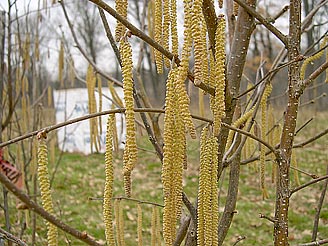 California Hazelnut (Corylus cornuta var. californica)
Paper Birch (Betula papyrifera)
Indian Plum (Oemleria cerasiformis) |
|||
|
If needed, trim roses now. This is the time to adjust the shape or size while the plants are just ready to break dormancy. Check garden tools. Clean, sharpen, replace handles, whatever maintenance needs to be done. While you are anticipating the spring garden, give the tools you will be using some extra love. Paint handles your favorite color, add a design, put an eyehook in the handle for hanging. Then turn your attention to a great storage space for them. A large bucket of sand with a bit of oil mixed in is a great place for garden tools. Rinse off the dirt and stick the business end in the bucket for storage. Rust begone! Have your soil tested. Your county extension office will have a list of places that test, often for free or low cost. Plant trees and deciduous shrubs. Monitor Rhododendron, Salal (Gaultheria shallon) and Huckleberries (Vaccinium) for root weevils. Wally wrote this back in 2000:
More about these pests--Oregon State University published a paper titled: "Speak No Weevil: What Rhododendron Growers Said About Their Root Weevil Management." Authors R.L. Rosetta and S.E. Svenson give details of a very interesting study done in 1998. www.extension.oregonstate.edu/catalog/html/sr/sr1065-e/07.pdf |
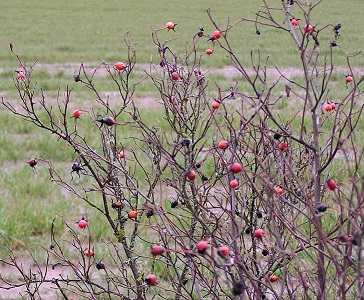 Rose hips
Weevil damage Photo credit: Whitney Cranshaw, Colorado State University |
|||
|
Sunshine, snow, hail and rain. March comes in like a lion, prances about like the gypsy queen she is and leaves in a huff. Spring is so much fun! Now that spring is officially around the corner, it's time to get out and take a look at the garden. Prune off flowering shrubs as they bloom (or prune them now and enjoy the bloom indoors! Frost may occur, and often. I keep a couple of old "sheet blankets" (a southern tradition--these are just flat sheets made of flannel) in my potting bench ready to drape over whatever has tender new growth whenever there is threat of frost. Slugs are awakening and becoming more active. Start your chosen treatment now. Rake up debris so the slugs won't feel so at home. Inspect your trees for winter damage. Trim up broken branches. Use them as 'a la carte' tenting when you need to protect beds or bushes. Get out your gardening journal and remind yourself of all those plans you made last year. Time to start them now? Or is it time to make a new plan? Clean up and divide perennials that flower in summer or fall now. You can tell perennials need dividing when the center becomes less vigorous or die out. Cut back ornamental grasses to a few inches above the ground to make way for new growth. Keep after weeds. You may not have been working out in the garden but the cool weather weeds have already been busy. Pull weeds like shot weed before they finish seeding to reduce next years weeding chores. For yourself, get some fresh air, clear out the cobwebs, start getting in shape for gardening time! |
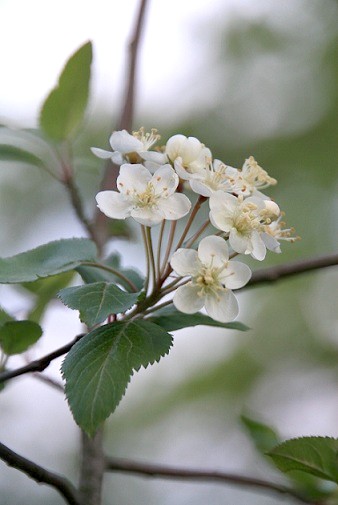 Oregon Crabapple (Malus fusca) |
|||
|
Spring makes its own statement,
April is traditionally rainy but trust our Earth to
break from the old ways in response to what we've done. Each day comes
with its own maestro, its own blueprint and its own whims. But make no complaints. Instead,
appreciate every moment. Dressing in layers for day trips is almost
mandatory unless one carries an entire wardrobe along. It's no wonder
nature is sometimes unpredictable (sometimes?).
April can be a sunny delight but we often hear
the weatherman announcing rain will be coming tomorrow. Good--it will
give those new plants an appropriate settling in. Fresh
plantings always enjoy a good soaking. On April 22, celebrate Earth Day by planting a native tree,
shrub or perennial in your yard. Green living is easy and economical once you learn how, especially in
the garden. By using plants native to your area, you are working with
nature rather than against it. You are also not paying for anything the
plants need. In fact, you can make additional plants by propagating the
ones you buy! The environment where plants grow naturally is perfectly suited to
each plant: NOTE: The components listed above are applicable only to natural
environments. If your landscape has been chemically enhanced and/or
artificially boosted it takes a few years of remedial un-treatment to bring
it back to its natural state. But you can start now by putting in native
plants for great beauty and delicious things to eat for you and
wildlife. Get rid of invasives--TAKE BACK YOUR YARD! |
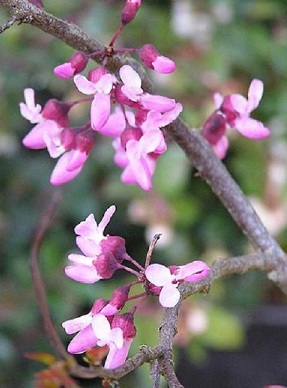 Western Redbud (Cercis occidentalis)
|
|||
|
This Mothers Day, honor Mom with a northwest native plant. May we suggest... There is a fascinating perennial called "Mother of Thousands" that can be grown indoors as a houseplant or outside in the garden. It's botanical name is Tolmiea menziesii. The leaves have a lovely shape and are covered sparsely with fine hair-like fibers. The sprightly little copper colored flowers with yellow-green edges bloom from the bottom of the stalk to the very tip-top. As each leaf matures, a new plant sprouts from its center. When grown in a hanging planter, these new 'children' give a lovely cascade effect. Use the Piggyback Plant for a ground cover beneath shrubs or trees. The little 'piggies' will take root to spread over bare earth. |
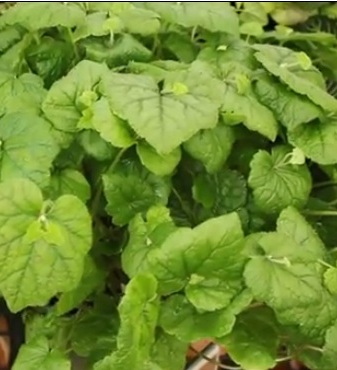 |
|||
|
Are you watering plants that have not yet matured? If you've just planted them this year, they will need some coddling during extended periods of rainless days. By this time next year when you offer a cooling drink of water, they'll say, "No, thanks. We're reaching our own." Until then, give them a good soak once a week or so. Even if they pretend they don't need it, do it anyway. And, if you've a mind to, say a few kind words and tell them how lovely they are. Watering the garden is a hot topic right now as we approach warmer weather with less rain. Native plants, once established, require far less water than non-natives. In fact, most won't need much care after their first season. But do keep a close eye on them the first year. They need help while their roots are marrying with the earth so they can find their own moisture. Give them a hand by watering well when they need it. Water early in the morning and then mulch to preserve that water and keep the soil temperature down. On super hot days, putting up a temporary shade for tender young plants will help a lot. Now that summer is officially here, our gardens are reaching toward their full annual displays. Flowering trees and shrubs continue to show their bloom potential. When the flowers have finished their pollination chores of attracting birds and bugs, the following fruits will be plentiful and the seeds within can be at their viable best. It's all part of nature's plan for each plant to reproduce itself, ensuring that the species will continue. Of course, there are sometimes kinks in that smooth-seeming path. And sometimes it is our own interference that is the culprit's core. For example, those wonderful plants from different lands or regions that we bring into our gardens because they are unusual, unique, but there are no natural mechanisms in place to fit them into the grand scheme. So, undaunted, they clamber without boundaries to destroy the tender wildflowers and polite ferns, courteous shrubs and modestly majestic trees that have grown here for hundreds of years. Oh, it is not only our gardener's ambition that is at fault. The hitchhiking seeds and stowaway bugs coming into our space unbeknownst to the traveling hosts on which they ride very often cause as much or more of a negative impact than the ones we invite. It is a small world, and we as lovers of native plants must be ever vigilant to these threats. We must act quickly and decisively to protect our gardens and wild spaces. Coming generations will be most grateful. Celebrate summer! Enjoy the out of doors in your garden--soak up a little sun (careful not to get burned!), watch a few birds, harvest delicious native plant berries (Serviceberry, Salmonberry, American Plum, Oregon Grape), take in some fresh air. Even the occasional summer rain is surprisingly refreshing when observed from a chaise lounge under cover of a patio or big umbrella. If you're having an outdoor get together, some Elderberry Fritters could wow your guests. See our Edible Northwest Native Plants page for how-to. I'm told these are delicious, especially if served with a little spruce tip honey. Red Columbine (Aquilegia formosa). Voted favorite native perennial by Oregon hummingbirds! This is the time we can kick back and enjoy the beautiful gardens we create. Unearth the cushions for the patio furniture, bring out some candles, plug in the fountain. But don't stop there--
If lazing about simply appreciating the day is not productive enough for you, try your hand at fashioning baskets or fans or wreath decorations from trimmings of trees or shrubs. Almost any species will do. Willows are famous weaving material but use whatever you have. Incense Cedar (Calocedrus decurrens) will lend their aroma to your creations. Junipers also have a distinctive fragrance. Vine maple (Acer circinatum) is easy to work with. I remember from my childhood when my mother and the lady next door would take big pans of snap beans out to the grape arbor and prepare them for cooking there in the shade. In times before air conditioning, folks went outside to catch cooling breezes. The backyard was our television, the birds and rustling of leaves were our stereo. |
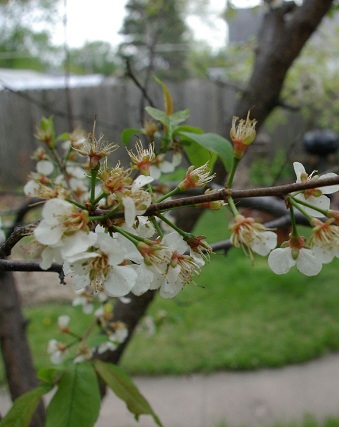 American Plum (Prunus americanum) Photo credit: Andrew Ciscel
Blue Elderberry (Sambucus mexicana)
Red Columbine (Aquilegia formosa)
Labrador Tea (Ledum glandulosum) |
|||
|
Hot Weather Warning! The unseasonably hot weather that has descended on Oregon's Willamette Valley this past week is not to be taken lightly. For plants--monitor carefully for signs of water deficiency, especially those new plantings. Provide shade by tilting an old umbrella over the plants or surrounding the plant with a few stakes and placing a piece of cardboard on top. Weight the cardboard down with a rock or two. Water early in the day and again at night if necessary. For people--drink lots of water, use sunscreen and if possible, stay indoors or at least in shade during the hot part of the day. The old adage, "Mad dogs and Englishmen go out in the noonday sun," is not just a funky folk tune! Check on elderly neighbors to make sure they're OK. 'Tis summer for sure, but not too late for planting shrubs and trees and water gardens, and it is the perfect time to divide clumps of northwest native perennials that have grown quite large. Funny thing about those perennials. If you leave them to repeat and repeat themselves, as is their wont, they will very often outgrow the space in which they are planted. When that happens they tend to stop being stars and turn into little twinkles. A sad situation for a beginning gardener, but so easily remedied! Simply water them well (to make it easy on yourself, they probably could care less), and using a sharp tool--anything from a shovel to a butcher knife--split the clump into nice sized portions. If your clump is a foot wide, cut it into three or four. Then plop the new sections into separate pots to share or plant them someplace else in your yard. If planting elsewhere, dig a generous hole, put in a scoop of compost, water well (this is a must, not an option), settle the new division firmly and backfill with the dirt that came out of the hole. Water again (also not an option) and snuggle up some mulch to help retain the water. Don't forget to give the same care to the remaining section of the original. Though the roots are well grounded, the disturbing event of loosing a big part of yourself is a bit of a shock. Surround your 'mother plant' with dirt, water and mulch. Hooray! Everyone is happy! Things to remember during this holiday:
|
Washington Monument
 San Diego |
|||
|
Warm weather can be a very expensive time of year if we depend on air conditioning and fans to keep us cool. Why not allow nature to help? Large shrubs or trees planted to the west or south of your home will shade and cool your house and yard. A group of birches can fit in a small space. If you have enough room, few trees are as good for shade as a northwest native maple. Work with the weather instead of fighting it. Open up the house in the evening and early morning, then close it up tight, curtains included, during the hot part of the day. Not only will the internal temperature be 20-30 degrees cooler, your furniture and carpets will not suffer sun damage. These are just a couple of ideas for beating the heat in the good old summertime. So much to do, so little time! The Oregon State Fair is here, there are vacation trips to take, kids going to and coming from camp, summer's last holiday is coming and school will be starting soon. In busy times the garden gets the least attention. Here are a few tips to get the most out of those spare moments we have to devote to our gardens. (Note: these tips are for established plants. See new plant care below.) Late Summer Gardening--The Bare Necessities (For Last Year's Plantings)
The other gardening chores can wait until you have time for them. Late Summer Gardening--The Bare Necessities (For The First Year)
For All Gardens Give yourself a few minutes every day to enjoy your garden. Slow down, smell the flowers, breathe in some summer air, have a glass of lemonade. It's the pause that refreshes. Fall planting season is just around the corner. It's time to:
Tomorrow begins the last weekend before school starts. Labor Day weekend usually includes a barbeque, picnic, visit to the State Fair or short camping trip. Inspect your garden. Look over the perennials, the shrubs and trees to see how they have all fared during the summer. Think about where you'll want another shrub or tree. Need ideas?
Celebrate the last days of summer by planting some beautiful northwest native perennial bulbs to enjoy next spring and for many years to come. Pale yellow Fawn Lilies, creamy white Trillium, vibrant orange Tiger Lilies, rare and exotic Chocolate Lilies--each one an exquisite picture of nature's charm. Traditionally in the United States, Labor Day is the end of summer, the start of school, the first football game, the last trip to the beach, the last family cookout. For gardeners, it's the end of the summer hiatus, the beginning of the fall gardening season. In the garden, Labor Day starts a wonderful new fall and winter season. This is the ideal time to plant containerized plants. The roots are well developed and establish quickly when planted out. Trees, shrubs and perennials planted in your gardens and landscape in the fall and winter get a real head start on next spring! Labor Day Traditions Besides the cookouts and weekend trips and just plain relaxing, there are many traditional events held on this celebration of the working folks. However you choose to celebrate, just take care of yourselves and each other.
In observance of our national holiday to honor labour, we bring this quote from a past president of our country.
Now there's a sentiment we wholehearted agree with! Going Camping? Before you go...... Give the garden a good watering. We may have rain but we may also have some hot, dry days. A little care now will be most appreciated by your landscape. Be especially generous with the water for those container gardens. They can dry out remarkably fast if given half a chance. |
SUMMER LILIES
Tiger Lily (Lilium columbianum)
Leopard Lily (Lilium pardalinum)
Lemon Lily (Lilium parryi)
Washington Lily (Lilium ) Photo credit: Wayne Rolle |
|||
|
School started this week for most kids and, weather permitting, those of us with a passion for gardening are outdoors getting our hands dirty. There are lots of chores to do right now--
Whatever your task, spending time in the garden will make your face smile and your heart soar. Honest! I noticed anew today that there is a vast difference in the way people think. A young lady mentioned to me that the weather makes her anxious for Halloween to arrive. She was all aflutter because she was going to dress her little 3-month old baby up in a costume for her very first Trick Or Treat. The weather does, indeed, affect me but I'm excited that it is finally planting season again! If you've been bitten by the gardening bug, fall sales will be the best treat you can give yourself. The trick will be deciding which of those maples would fit that perfect spot in your yard or perhaps an evergreen would be better. Perhaps a northwest native cutting garden with Oregon Iris and Idaho Blue-Eyed Grass and some Lemon Lilies! Every year about now, nurseries mark plants down to clear out the stock they don't want to hold over through winter. Take advantage of this phenom! Here in the northwest, autumn has arrived. The welcome rain falls on the parched ground, and the plants embrace this needed moisture. Gardeners begin thinking about trimming, tidying up the landscape and planting. Consider planting a container to enjoy all winter. Choosing the right plants will give a beautiful look to your porch or entryway or patio. You can even put a pot right in an existing bed or beneath a deciduous tree. There are many choices for an evergreen container. We give just two ideas here. The Pacific Rhodie pairs quite nicely with the Sword Fern. The contrast of leaf shape and color is a good pairing, and when the Rhodie blooms in the spring it will be an elegant sight. Everyone loves the Blueblossom it seems and it's shiny dark green leaves are a good contrast with the round leaves of the Evergreen Violet. Come spring, the yellow blooms beneath the Blueblossom will be very pleasing A Seed See how a Seed, which Autumn flung down, And through the Winter neglected lay, Uncoils two little green leaves and two brown, With tiny root taking hold on the clay As, lifting and strengthening day by day, It pushes red branchless, sprouts new leaves, And cell after cell the Power in it weaves Out of the storehouse of soil and clime, To fashion a Tree in due course of time; Tree with rough bark and boughs' expansion, Where the Crow can build his mansion, Or a Man, in some new May, Lie under whispering leaves and say, "Are the ills of one's life so very bad When a Green Tree makes me deliciously glad?" As I do now. But where shall I be When this little Seed is a tall green Tree? It's officially autumn and planting time is here. Today in the Willamette Valley, the sun is shining and the rain we've had this week has left the earth soft enough for easy digging. There is a crispness to the air but it's warm enough for shirtsleeves. To my way of thinking, it's absolutely perfect planting weather! Ode to Autumn by John Keats Close bosom-friend of the maturing sun; Conspiring with him how to load and bless With fruit the vines that round the thatch-eaves run; To bend with apples the mossed cottage-trees, And fill all fruit with ripeness to the core; To swell the gourd, and plump the hazel shells With a sweet kernel; to set budding more, And still more, later flowers for the bees, Until they think warm days will never cease, For Summer has o’erbrimmed their clammy cells.
Who hath not seen thee oft amid thy store? Sometimes whoever seeks abroad may find Thee sitting careless on a granary floor, Thy hair soft-lifted by the winnowing wind; Or on a half-reaped furrow sound asleep, Drowsed with the fume of poppies, while thy hook Spares the next swath and all its twined flowers; And sometimes like a gleaner thou dost keep Steady thy laden head across a brook; Or by a cider-press, with patient look, Thou watchest the last oozings, hours by hours. Where are the songs of Spring? Ay, where are they? Think not of them, thou hast thy music too, - While barred clouds bloom the soft-dying day And touch the stubble-plains with rosy hue; Then in a wailful choir the small gnats mourn Among the river sallows, borne aloft Or sinking as the light wind lives or dies; And full-grown lambs loud bleat from hilly bourn; Hedge-crickets sing, and now with treble soft The redbreast whistles from a garden-croft; And gathering swallows twitter in the skies. Summer has gone as Oregon slides into fall. Days are cooler for the most part. The first faint frosting appeared on windshields here in the Willamette Valley a few days ago. Vegetable gardens are being pulled and mulch is spread. Savvy gardeners have covered their garden beds tightly with black plastic that will allow moisture to come in but prevents growth. In fact, any weed seeds left in the earth will be cooked by spring. It's time to clean up the perennial beds and think about what new plants you'd like to add, for this is prime time for planting! Bargains are to be had as nurseries are selling off the last of their trees, shrubs and perennials. A green thumb fact: fall planting works with nature instead of against it. Settled into their new homes, we can rely on nature to provide most of the watering once the rain begins. We do need to keep an eye on these newly bedded plants but compared to spring planting, the chores are ever so much easier in the fall. |
Evergreen Containers
Pacific Rhododendron (Rhododendron macrophyllum) with Sword Fern (Polystichum munitum)
Evergreen Violet (Viola sempervirens) with Blueblossom (Ceanothus thrysiflorus)
|
|||
|
Autumn burned brightly, a running flame through the mountains, a torch flung to the trees. ~ Faith Baldwin Fall Color Hotline The US Forest Service offers a service that provides up-to-date information for this season. Call the Fall Color Hotline at 1-800-354-4595. Pick the location you are interested in from the list of mailboxes and recorded messages give the current areas for best fall foliage views. See their website at www.fs.fed.us/fallcolors/. Clicking on your state will take you to the current Autumn Colours Report. The site for the Pacific Northwest is awesome--beautiful photographs and excellent information. This is a great idea and the work creating and maintaining the data is commendable. Our northwest native Fawn Lily (Erythronium Oreganum) is a lovely little lady who blooms pale yellow in the mid to late spring. Her mottled twin leaves form the exquisite natural vase from which the slender stalk rises and presents her bloom, shyly downcast but gently dancing on easy breezes. John Burroughs, a beloved American Naturalist, is often credited with naming this species "fawn lily" because he thought the leaves resembled the ears of an alert young fawn. But maybe he thought the mottling of the leaf color reminded him of the fawn's color. Here's what he wrote about Autumn in his 1921 essay "The Falling Leaves": The time of the falling leaves has come again. Once more in our morning walk we tread upon carpets of gold and crimson, of brown and bronze, woven by the winds or the rains out of these delicate textures while we slept. This fall, take a page from John Burrough's diary: plant a native bulb garden. Fall is such a fun season! The air is energized with cooler temperatures and brisk breezes. The verdant green we've enjoyed all spring and summer is moving into golden reds and bronze scarlets. Seed pods are architectural wonders in shades of silver and brown, perfect for combining with cattails and some of those fantastic autumn leaves. Days are shorter now, evening falls earlier to tell us 'scurry on home.' Families gather together at harvest time to share tomatoes and squash. And for gardeners, fall planting season encourages a new living hedge, a cutting garden or wildlife habitat. A little watering must be done when the plants go in the ground but in no time at all nature will take over that chore for us. Our newly planted darlings will spread their roots and become deeply established while we sip a cup of tea and enjoy the warmth of being indoors on a blustery day. The air has turned that particular combination of warm and chill that means fall is here. Leaves are turning colors. Days are shorter. And here in the northwestern United States we've begun to get some rain again. Photographers are enjoying the softer light. Painters are inspired to put this beauty on canvas. But to gardeners, it's the most exciting time of year--it's planting time! Nature has begun taking charge of watering and gardeners are free to spend time in other ways. Elderberries are full of fruit right now. Not quite ready to eat but they will be soon. The fruit is tiny little berries in a cluster at the end of the branches. As they ripen, their weight makes the branch bend downward--easy to pick! And the birds adore them. Guess what color our Evergreen Huckleberries are right now? Red! Brilliant, vibrant, glowing red! How can that be? I'm sure Wally would have had the answer to that question but as for me, I'm just awestruck by this fantastic color! Now that's a real show-stopper for the autumn garden. And just think: just a few short weeks ago this same shrub was covered in delicious huckleberries (that was Wally's favorite, you know). Every day, nature treats us to a new show of autumn. The nuance of color is beauty incarnate. Vine Maples' color changes from summer green to a tinge of russet around the edges, then gradually ripen to scarlet and orange and gold. Dogwood leaves are green and bright red, all on the same branch. Birches and oaks are golden to bronze to the color called "burnt sienna" in a child's box of crayons. Wally says, "This is the start of the annual "show" that nature puts on - a new show every day! "Seen or unseen, beauty is it's own excuse for being." How about a living Holiday tree? Consider choosing a northwest native pine or fir for your holiday. Put it in a pot and it will be ready to decorate before Santa comes. When others are scrambling for a tree you'll have time to bake cookies! And think of the money you'll save! Is your garden ready for winter? It's time to tidy up:
Clean birdbaths. Either turn upside down so water won't collect there, keep in place to allow rainwater to collect or invest in one of those birdbath heaters that keep the water from freezing. There are valid arguments for all three approaches. Use your own judgment. One caveat--if you are going to continue with water in them you must check them every day or so. If you use a heater and the water is gone it may kill the heater or fry birds that land there. If you let nature fill them, check that no nasty things have fallen in to ruin the water. If you're interested in building a certified wildlife habitat, there are lots of places on the internet that tell exactly what to do and how to do it. One of these is the National Wildlife Federation's site at www.nwf.org/gardenforwildlife. It's a very user friendly website that also lists some of the benefits of attracting wildlife to your yard such as eliminating the need for killing insects. The birds will take on that chore for you, killing bugs that crawl, fly or slime (yes, I'm referring to slugs--birds find them quite tasty!) It will come as no surprise to native plant aficionados that the plants recommended to include in your wildlife habitat are native to the northwest. Doesn't the fall weather send energy right down to your toes? Our afternoon sunshine this week has been glorious for strolling around the garden, snipping a wayward branch here, taking off a broken twig there, smelling the richness of oaks and mosses. Aahh, autumn is such a delight! |
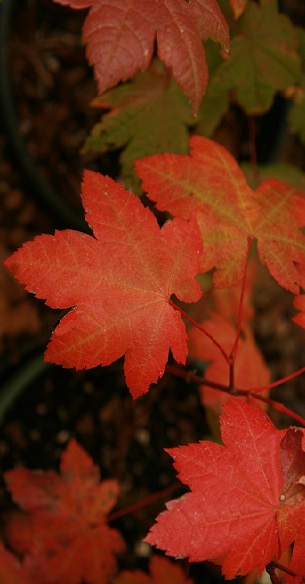
|
|||
|
Remember when the leaves were a kaleidoscope of color? (Last week!) Nature has provided a very wet and windy few days and now the majority of the leaves are carpeting the earth. But in it's their own way, that mat of leaves is every bit as lovely as when they were on the trees. The random pattern and variety of color is intriguing, and the bark and shape of the tree above is pleasing to the eye. If you're feeling a little overwhelmed by the weather, try armchair gardening. Get a nice cup of cocoa, print a copy of our online catalog and dream of next year's garden. Somehow the weather seems nicer from your warm nest. Green Living Tips Daylight savings time ends this weekend. When you check your clocks, also check your smoke and other detectors. Replace incandescent light bulbs with compact fluorescents. There's a style and type to suit every light fixture inside and outside, including lamps. This is a simple act everybody can do and the results are astounding: ENERGY STAR qualified bulbs use about 75 percent less energy than standard incandescent bulbs and last up to 10 times longer. Save about $30 or more in electricity costs over each bulb's lifetime. Produce about 75 percent less heat, so they're safer to operate and can cut energy costs associated with home cooling. If every American home replaced just one light bulb with an ENERGY STAR qualified bulb, we would save enough energy to light more than 3 million homes for a year, more than $600 million in annual energy costs, and prevent greenhouse gases equivalent to the emissions of more than 800,000 cars. http://www.energystar.gov/index.cfm?c=cfls.pr_cfls Autumn planting--it's not too late to plant! Those end of season gardening chores would be far more fun if you include a new shrub or tree on your to-do list. But don't wait too long. Winter will soon be here. Be on the lookout for bare root sales. These plants are harvested at their maximum dormancy, both deciduous and evergreen shrubs and trees. The digging period usually runs from December through March. You can plant them as long as the ground is not frozen, or they can be healed in a bed of dust or other mulching material until spring. Weather-stripping! Now's the time to check weather-stripping around doors and windows. It's easy to replace or repair. There are lots of different kinds at different prices. Get thee to the hardware store and check them out. What's the use of keeping your home toasty warm when the cold can sneak right in? Make door snakes: stuff old socks full of just about anything (smashed up pine cones or needles, old rags, pantyhose) and stitch them together to form a tube as long as your door is wide. What to do about spiders? Nothing! Leave them alone! Spiders are one of the world's best pest eradicators. According to Ramona Frances, University of California Master Gardener, "Every year, billions of spiders do away with a large number of disease-carrying and crop-destroying insects. If every spider ate just one a day for a year, those insects, piled in one spot, would weigh as much as 50 million people." And to that I say, "Cool. Just keep them out of my house." My personal opinion about all bugs is this: if they're outside, let them live. If they're inside, they get squished. End of story. Leaves are blowing everywhere! Rain is coming down in soft patters, then in slanted sheets as the wind picks up again. Time to plant? Sure! You can don your rain slicks, pull up your hood and brave the weather. Or you can wait for a break in the wind and rain to sally forth with your spade and plant. But hurry! The calm will not last long! Do you know the leaves that have fallen will make beautiful compost for free? It's easy! Here's how:
That's it! The materials will begin to cook (compost), reaching a nice warmth in just a few days. Check it every once in a while to make sure it's still damp. You want it damp but not soggy. Dry materials take a long time to compost--some never do! By spring you'll have a goodly supply of what gardeners call "black gold." My favorite compost bin, old-fashioned wattle design of branches trimmed from a hazelnut tree. Any trimmings would work as long as they are not poisonous. / A cottage-inspired bin of picket fencing. Charming! / Solid and dependable, rocks stacked loosely in a circle resemble an old well. The slate piece at top shelters from excessive rain.
Wildlife Habitat Update: Are your squirrel feeders full? Have you put out suet feeders for the birds yet? Is there a safe spot in your garden where little ones can find shelter? If your landscape is missing any of the key ingredients for wildlife habitat, now's the time to plan for next year's planting. Not only will you be adding beauty to the garden, you'll also add elements of life. A never ending display from nature! It's composting time! The leaves have fallen, the perennials have been trimmed--turn that debris into gold! The late fall weather is bringing lots of wind and rain and cool nights. During the day, the temperature varies from 40's to 50's but when the sun shines, the thermometer still rises sometimes as high as 70. Fluctuations like this can wreak havoc on outdoor plants. Mulch well to prevent damage. If you have your native plants in pots, protect their roots from freezing with a good mound of mulch. You can bury the lower half of the pots for good protection. Once the plants get cold, give them cover to keep the sun from warming them up again. It's actually the warming after they get cold that causes damage. Best to let them stay cold and dormant until springtime. Walt Whitman wrote the following poem about things he was thankful
for. Thanks in Old Age By Walt Whitman (1819-1892) Thanks in old age--thanks ere I go, For health, the midday sun, the impalpable air--for life, mere life, For precious ever-lingering memories, (of you my mother dear--you, father--you, brothers, sisters, friends,) For all my days--not those of peace alone--the days of war the same, For gentle words, caresses, gifts from foreign lands, For shelter, wine and meat--for sweet appreciation, (You distant, dim unknown--or young or old--countless, unspecified, readers belov'd, We never met, and neer shall meet--and yet our souls embrace, long, close and long;) For beings, groups, love, deeds, words, books--for colors, forms, For all the brave strong men--devoted, hardy men--who've forward sprung in freedom's help, all years, all lands For braver, stronger, more devoted men--(a special laurel ere I go, to life's war's chosen ones, The cannoneers of song and thought--the great artillerists--the foremost leaders, captains of the soul:) As soldier from an ended war return'd--As traveler out of myriads, to the long procession retrospective, Thanks--joyful thanks!--a soldier's, traveler's thanks. |
It was one of those perfect English autumnal days which occur more frequently in memory than in life. ~ P.D. James
As we express our gratitude, we must never forget that the highest appreciation is not to utter words, but to live by them. ~ John Fitzgerald Kennedy
|
|||
|
As I write today, the chilly weather outside tells me it's time to make sure the gardens are all ready for winter. Although native plants are far more carefree than aliens, there are chores to do. If you have just established native plantings in the last two years, be especially nice to the young garden. Do a thorough job of cleaning up around the new plantings--remove dead leaves and any trash, at least 5 feet around the plants. Overhead growth such as fir branches should be pruned back so the plants underneath get as much winter sunshine as possible and to minimize any falling branches or debris. Any diseased branches on your plants should be pruned away. Those plants subject to strong north winds should have some protection, even plastic wraps or other coverings on "standby" for unusual cold. Even old blankets or drapes will work. Use plenty of mulch to further protect roots. This could be bark or leaves or straw or compost. Many natives will tolerate frozen roots but do not count on that. These tasks are good for all gardens, but very important until your plants are fully settled in. As we pause this winter for the holiday season, remember the people who give their all for us--the firemen and law enforcement officers who fight crime and fires, the doctors and nurses who patch us up when we are broken, and especially please remember the men and women who give up a time of their lives to protect us as marines, soldiers, sailors, pilots, all those people serving in the armed forces. We can sleep in peace tonight because of them. I heard the bells on Christmas Day Henry Wadsworth Longfellow 1864 I heard the bells on Christmas day Till ringing, singing on its way And in despair I bowed my head Then pealed the bells more loud and deep: |
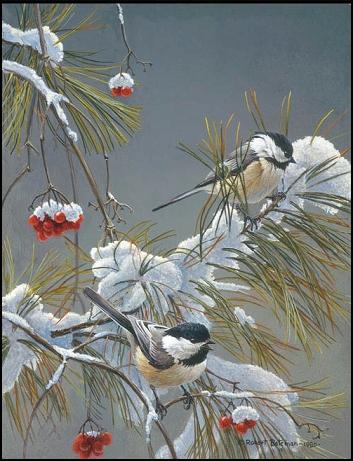 Winter Song - Chickadees by Robert Bateman "Chicka-dee-dee-dee, chicka-dee-dee-dee is the call in the garden and the woodland that warms the coldest winter day. These bouncy balls of fluff always seem happy and full of energy. Here I have tried to keep in tune with their mood by showing the bright red highbush cranberries and the white pine needles bursting through the clumps of snow." ~ Robert Bateman about his painting, Winter Song - Chickadees. |
|||
|